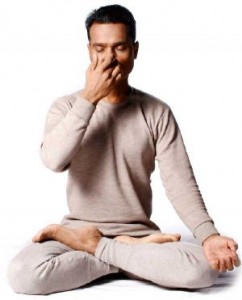 Introduction to Pranayama
Introduction to Pranayama
Pranayama, the formal practice of controlling the breath, is one important aspect of Yoga. The ancient sages taught that prana, the vital force circulating through us, can be cultivated and channeled through a variety of breathing exercises. In the process, the mind is calmed, rejuvenated, and uplifted. Pranayama serves as an important bridge between the outward, active practices of yoga asana – and the internal, surrendering practices that lead us into deeper states of meditation.
Therefore, the mantra recitation (japa), fire sacrifice (homa), worship (arcana), etc., must be done [in such a way, so that its performance] is balanced/harmonized with the breath (prana).
Student, tell me, what is God? He is the breath within the breath.
– Kabir
Regular practice increases and enhances the quantity and quality of prana, clears blocked nadis and chakras, and results in the practitioner feeling energetic, enthusiastic and positive.
Skull Shining Breath
Kapalabhati
Kapalabhati is an intermediate-to-advanced pranayama that consists of short, powerful exhales and passive inhales. This exercise is a traditional internal purification practice, or kriya, that tones and cleanses the respiratory system by encouraging the release of toxins and waste matter. It acts as a tonic for the system, refreshing and rejuvenating the body and mind.
- In a seated position, rest your hands on your knees, palms facing down.
- Bring your awareness to your lower belly.
- Inhale through both nostrils deeply.
- Contract your low belly, forcing out the breath in a short burst.
- As you quickly release the contraction, your inhalation should be automatic and passive – your focus should be on exhaling.
- After the duration of the exercise, inhale deeply through the nostrils, and then exhale slowly through your mouth.
Three Part Deep Breathing
Deergha Swasam
Practicing Deerga Pranayama teaches you to breathe fully and completely. Ineffective breathing is a common problem in today’s modern world, compounded by poor posture and long periods of sitting or driving. When you breathe shallowly (called “chest breathing”), the air only enters your upper chest and very little enters your lower chest. This causes a lack of oxygen to your blood vessels, which can create strain on your heart and lungs.
Learning to breathe deeply will increase your oxygen supply, which, in turn, will help to decrease stress and anxiety levels. Additionally, focusing on your body during Three-Part Breath brings awareness to the present moment and calms your mind. According to studies, you can inhale and exhale up to seven times as much air (and oxygen and prana) during a three-part breath than in a shallow, chest-based breath.
- In a seated position or lying down, place your left hand on your low abdomen, a few inches below your belly button, and place your right hand on your chest.
- Begin to focus your awareness on your breath as it moves in and out of your body through your nose.
- On your inhalations, feel the natural lift of your belly, followed by the expansion of your ribs, and finally allow your chest to rise slightly so that even your shoulders rise.
- On your exhalations, feel your shoulders drop, the slight compression of your ribs, followed by the drop of your belly. Exhale completely, pressing very gently on your abdomen to help expel air.
- As you continue to breathe, keep your awareness on this three-part movement. As you inhale, your belly lifts, your ribs expand, and your chest rises. As you exhale, your chest drops, your ribs contract, and your belly softens and lowers.
- Continue at your own pace, gradually letting the three parts of the breath flow smoothly without pausing.
- Continue for up to five minutes, or for as long as you feel comfortable.
It’s time to connect with the nurturing and supportive energy of Mother Earth and remember the peace that comes when we simply take a moment to breathe deeply and enter the stillness. There has been a lot of energy churning in the cosmos, and the easiest and simplest thing we can do to regain our balance is come back to our breath. Slow deep breaths open the way, so remember to breathe.
Alternate Nostril Breathing
Nadi Shodhana
Nadi Shodhana will cleanse and purify the nadis, which will allow for a smoother flow of prana throughout the body, mind, and spirit. When prana becomes unbalanced, due to mental and physical stress, the nadis become blocked, which can lead to illness and disease. If you notice that your emotions are out of control, this technique will be really beneficial for you. Keeping the nadis cleansed will lead to overall wellness and peace in all areas of life.
- In a seated position, with your right hand, bend your index and middle fingers, keeping your ring finger, pinkie finger, and thumb extended. This hand position, or mudra, is called Mrigi Mudra.
- Close your right nostril with your right thumb.
- Inhale deeply through your left nostril.
- At the top of your inhalation, close your left nostril with the ring finger of your right hand as you release the right nostril.
- Exhale through your right nostril.
- Keeping the left nostril closed, inhale deeply through your right nostril.
- Seal your right nostril again with your thumb, then release your left nostril.
- Exhale out of your left nostril. You should now be in the original position, with your thumb sealing your right nostril. This is one cycle.
- Balance your inhalations and exhalations so they are the same length through both nostrils.
- Repeat up to 10 full cycles, gradually increasing the number of repetitions as you gain experience.
Breath Retention
Kumbhaka
When in deep meditation, I experience the cessation of breath. In the Bhagavad Gita it is described as the incoming breath going into the outgoing breath, both intertwining into the other becoming one.